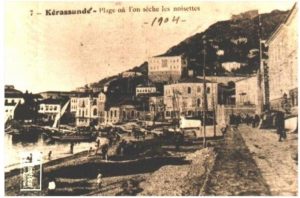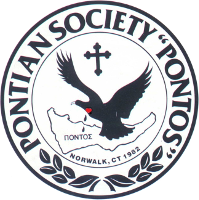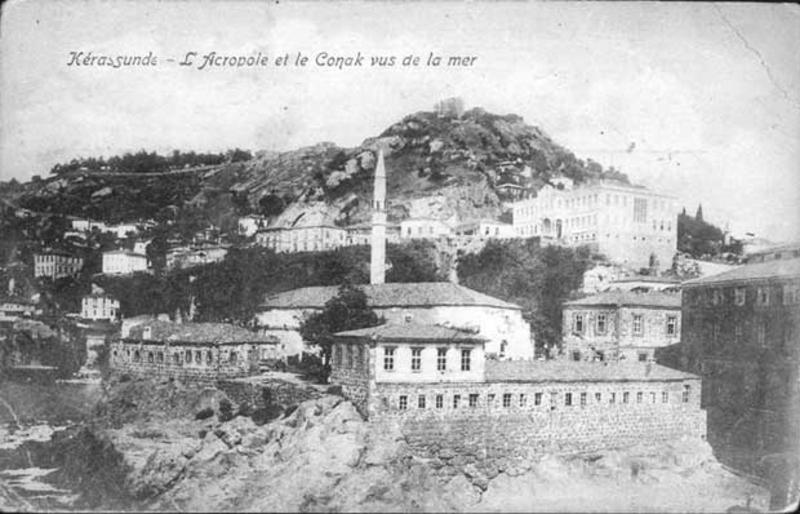The jewel and the boast of Kerasounta. Its old castles with huge boulders look as if they were built to decorate the landscape and not to fortify it. They project so naturally, gently, calmly. Access to the castle and the citadel was possible from many sides. The plateau on the citadel was always covered with grass and planted, thanks to the efforts of the late Captain George Pasha, with evergreen trees, especially spindle trees (ornamental plants). At one point in the castle begins an underground tunnel which according to the legends of the ancients ended down on the beach where a mouth that we saw on the sides of the rock, was considered the exit of the tunnel.
The plateau on the citadel was always covered with grass and planted, thanks to the efforts of the late Captain George Pasha, with evergreen trees, especially spindle trees (ornamental plants). At one point in the castle begins an underground tunnel which according to the legends of the ancients ended down on the beach where a mouth that we saw on the sides of the rock, was considered the exit of the tunnel.

There the deceased Tsironas set up his nets to catch quails. That green location was our favorite place for the toys we set up both on land and at sea. Inside the cave of Agios Ilias, the Turks had placed the eponymous kouledes (primitive cannon balls) intended for an old cannon that fired morning and night during the days of Ramadan for the beginning and the end of the night blessing of the Muslims. With the center of the citadel, the districts of Kerasounta stretched around. On the right the port for steamships, on the left the other port for sailboats that were once plentiful. Above the Acropolis, the eyes of the viewer embraced almost the entire city. First of all, the City Hall. Further on Kambou – Kaveshin, Limeni, Ypsilon, Theama, with its cold crystal clear water and closer to it Kastroportin (the entrance of the castle), by Captain Yordan, Tsironin, Kaya Tasin, Kokaris, Geni Yolou, Sai Tasin. The Armenian parish of Kum Giali and the Turkish Hadji Isain and Tsinarlar. Another jewel of Kerasounta was the islet of Aritia, the only island in the Black Sea. She shone like a bride in the waves with the ruins of the ancient temple of Areos. Tradition has it that the opposite location of Kokari was related to this temple, that is, the second component of its name comes from the god Ares. The Argonauts came and went to Aritiada when they escaped from the persecution of Aetos thanks to the inhuman trick of Medea and made sacrifices to the god Ares. On the beach opposite Aritiada are the estuaries of the small river Ak soyou, near which, according to tradition, the palaces of Farnakos and, according to others, Mithridates were located, as coins with the word Mithridates had been found…. This river originates from the famous suburbs of Kula kagia. There was also the factory of N. Delikaris which supplied the overlying rich forests of pines and firs that employed about 150 workers. The predominant product of Kerasounta was the hazelnut (Pontian karyon, in botany or leptokaryon or leftokar). The cultivation and trade of the hazelnut managed to occupy most of the population of the city and the surrounding areas. The processing (breaking-peeling-cleaning) was done in special workshops where both adults and underage men and women were employed. Each workshop had low benches (tables) on which a huge pile of broken hazelnuts was placed. Around the bench sat twenty to three girls, the kanzokoritsa, whose task was to choose the fruit, the crumb called kanzin from the bark called chapli. The pure fruit was collected in sacks while their skins were left on the floor. At night they weighed the fruit for every six okkas (about 7.5 kg), the workers were paid a piaster (Turkish money of that time), the bark was sold as fuel, and many of Kerasounta’s trading houses, engaged in the collection and export of valuable hazelnut fruit in Europe. We mention: Pisani Brothers (England-Germany), K. Konstantinidis (Marseille) who was succeeded by Angelos Deligiorgis nephew from the sister of the late Konstantinidis, Mavridis Brothers (Odessa), Aslanidis Brothers and many others.
This river originates from the famous suburbs of Kula kagia. There was also the factory of N. Delikaris which supplied the overlying rich forests of pines and firs that employed about 150 workers. The predominant product of Kerasounta was the hazelnut (Pontian karyon, in botany or leptokaryon or leftokar). The cultivation and trade of the hazelnut managed to occupy most of the population of the city and the surrounding areas. The processing (breaking-peeling-cleaning) was done in special workshops where both adults and underage men and women were employed. Each workshop had low benches (tables) on which a huge pile of broken hazelnuts was placed. Around the bench sat twenty to three girls, the kanzokoritsa, whose task was to choose the fruit, the crumb called kanzin from the bark called chapli. The pure fruit was collected in sacks while their skins were left on the floor. At night they weighed the fruit for every six okkas (about 7.5 kg), the workers were paid a piaster (Turkish money of that time), the bark was sold as fuel, and many of Kerasounta’s trading houses, engaged in the collection and export of valuable hazelnut fruit in Europe. We mention: Pisani Brothers (England-Germany), K. Konstantinidis (Marseille) who was succeeded by Angelos Deligiorgis nephew from the sister of the late Konstantinidis, Mavridis Brothers (Odessa), Aslanidis Brothers and many others.
Before the discovery of steam navigation, most Kerasountians were sailors with a significant number of sailboats, as was neighboring Tripoli. After the displacement of the sailboats from the steamships, most of the people of Kerasounti indulged in trade and the arts.

